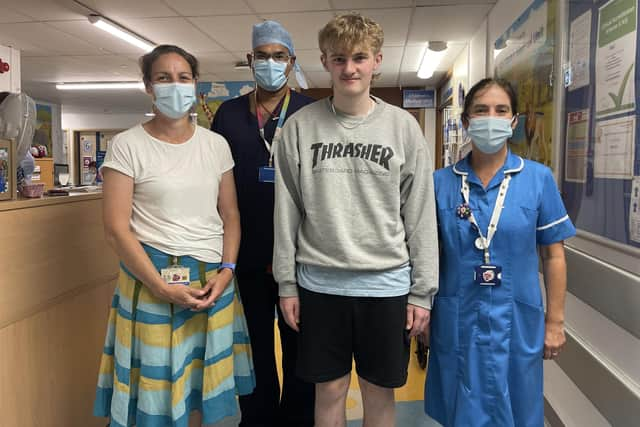Hampshire teenage boy who suffers rare brain aneurysm survives against the odds as part of his skull is stitched into back
and live on Freeview channel 276
Warrick Allon was rushed into emergency surgery to try and reduce pressure in his skull following a brain haemorrhage. He survived the surgery but was left unable to talk, walk or eat after developing a syndrome common with such invasive surgery close to the brain.
SEE ALSO: Hovertravel cancels services
But now, thanks to the expertise of surgeons and a specialist neurological rehabilitation team at Southampton Children’s Hospital, Warrick is able to walk and communicate again – and has even returned to school part-time.


Advertisement
Hide AdAdvertisement
Hide AdWarrick, 15, from Andover, started to complain of a headache while at home with his mum Krissie Thatcher and stepdad Paul Thatcher on April 7 – minutes later he collapsed and was unresponsive. He was rushed by ambulance to hospital.
Scans showed he had an arteriovenous malformation (AVM) - an abnormal tangle of blood vessels - that had ruptured causing a large blood clot to form and bleed on his brain.
Aabir Chakraborty, neurosurgeon at Southampton Children’s Hospital, led the team in the emergency operation to reduce the pressure build-up.
The operation also involved removing part of Warrick’s skull, which was stitched into his back during surgery to allow for the swelling around the brain to reduce and to preserve the bone.
Advertisement
Hide AdAdvertisement
Hide AdMr Chakraborty said: ‘I could see that this was an unusually large blood clot that had caused considerable pressure around Warrick’s brain stem, the lower part of the brain that is connected to the spinal cord.
‘I was very concerned that he was at high risk of imminent brain death, and so it was imperative we got him into surgery as quickly as possible. He had an excessive amount of bleeding which made this a difficult operation to perform.
‘Once we had secured the drain, we continued with tackling the blood clot which involved removing a part of Warrick’s skull to help reduce the swelling at the back of his head.’
Mum Krissie said: ‘I will remember that moment forever. We asked what Warrick’s chances of survival were and were told it was 50/50.
Advertisement
Hide AdAdvertisement
Hide Ad‘It all happened so quickly but I remember telling Mr Chakraborty that my boy wasn’t going to die. It wasn’t denial, it was determination – he wasn’t going to die that day.’
When Warrick woke, he was unable to speak or move and was suffering with Posterior Fossa Syndrome (PFS) – a rare condition that can develop after brain surgery.
Initially Warrick was unable to talk, walk or move easily but, after just two weeks, he was able to sit in a chair for 10 minutes. After three months he was eating, speaking fluently, and walking slowly.
Warrick has since undergone two further operations and has astounded medics with his recovery. He has now returned home and is back at school part-time. He will continue his outpatient rehabilitation programme, with the ultimate aim of taking his GCSE exams and attending college in 2023.
Advertisement
Hide AdAdvertisement
Hide AdWarrick’s Dad Dave said: ‘We can’t thank Mr Chakraborty and the amazing team at Southampton Children’s Hospital enough.
‘What they have done is nothing short of miraculous, they didn’t just save his life, they have returned him home to us and we will be forever grateful for that.’